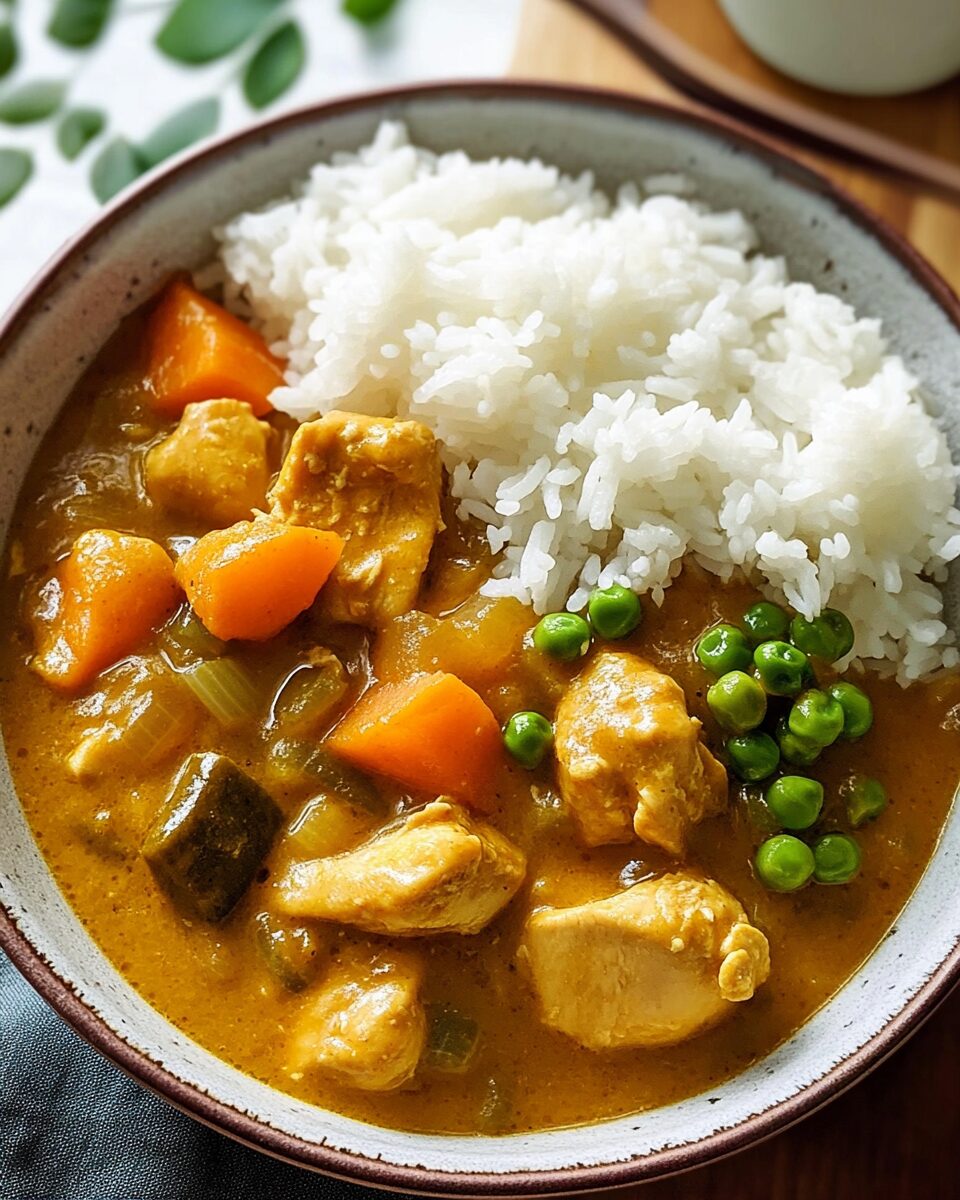The aroma of this Japanese Chicken Curry is enough to transport you straight to a cozy kitchen in Tokyo. Tender chicken, soft potatoes, and sweet carrots are simmered in a richly spiced curry sauce that strikes the perfect balance of savory and sweet.
It’s an ideal weeknight dinner that feels special, yet comes together with simple pantry ingredients. The addition of grated apple brings a unique sweetness, while the homemade curry roux creates that iconic silky texture. Serve it over warm rice for a truly satisfying dish that comforts from the inside out.
Full recipe:
Ingredients:
-
1 lb boneless, skinless chicken thighs, cut into bite-sized pieces
-
2 tablespoons vegetable oil
-
1 large onion, thinly sliced
-
3 cloves garlic, minced
-
1 tablespoon grated ginger
-
2 carrots, peeled and chopped
-
2 Yukon gold potatoes, peeled and diced
-
4 cups low-sodium chicken broth
-
1 apple, grated
-
1 tablespoon ketchup
-
1 tablespoon soy sauce
-
1 tablespoon curry powder
-
3 tablespoons flour
-
2 tablespoons butter
-
Cooked white rice, for serving
-
Salt and pepper to taste
-
Fresh parsley or scallions for garnish (optional)
Directions:
-
Heat vegetable oil in a large pot over medium heat. Add chicken, season with salt and pepper, and cook until lightly browned. Remove and set aside.
-
In the same pot, add sliced onions. Cook for about 5 minutes until soft and golden.
-
Add garlic and ginger. Stir for 1 minute until fragrant.
-
Add carrots and potatoes. Stir to combine.
-
Return the chicken to the pot. Pour in the chicken broth. Add grated apple, ketchup, and soy sauce.
-
Bring to a boil, then reduce heat to low and simmer for 30 minutes, or until vegetables are tender and chicken is cooked through.
-
In a small pan, melt butter. Add flour and curry powder, and cook for 1–2 minutes to make a roux.
-
Stir the roux into the curry to thicken. Simmer another 5 minutes. Adjust seasoning with salt and pepper as needed.
-
Serve hot over cooked rice and garnish with parsley or scallions if desired.
Prep Time: 15 minutes | Cooking Time: 45 minutes | Total Time: 1 hour
Kcal: 435 kcal | Servings: 4 servings
Cultural Significance in Japan
Curry in Japan has moved far beyond its foreign origins to become an essential part of the national diet. In fact, it’s so popular that you’ll find entire restaurant chains dedicated to serving different variations of curry. It’s a go-to meal for families because it’s budget-friendly, easy to prepare in large quantities, and customizable to suit all taste preferences and dietary needs.
In Japanese culture, curry is associated with warmth and familiarity. It’s not uncommon for people to have vivid memories of a parent’s or grandparent’s version of this dish, often served during childhood or special family dinners. It represents home, care, and everyday nourishment.
Unique Characteristics of Japanese Curry
What truly sets Japanese curry apart is its flavor profile and consistency. It is typically sweeter and milder than other types of curry. This sweetness often comes from the addition of grated apple or honey, while the richness is enhanced by the use of butter and flour to create a thick roux. These elements combine to make a curry that is comforting, approachable, and deeply flavorful without being overpowering.
The dish also commonly includes chunks of tender chicken, soft potatoes, and carrots—all simmered in a savory curry sauce until melt-in-your-mouth tender. The vegetables absorb the curry flavor, becoming a delicious and wholesome part of the meal.
Another defining feature is the serving style. Japanese curry is almost always plated over steamed white rice, forming a dish called kare raisu, or served with fried cutlets like katsu kare (curry with breaded pork cutlet). The simplicity of presentation allows the rich, golden-brown sauce to take center stage.
Why Japanese Curry is Perfect for Families
Japanese Chicken Curry is one of those rare dishes that both kids and adults adore. Its mild spice level makes it accessible to those who aren’t fans of heat, and the naturally sweet and savory balance is appealing to a wide variety of palates. Parents often find it an easy way to introduce children to curry without overwhelming them.
It’s also a fantastic meal prep option. The flavors deepen over time, meaning leftovers taste even better the next day. Plus, it’s an excellent way to incorporate vegetables into a child’s diet—potatoes, carrots, onions, and even peas or corn can easily be added without fuss.
Beyond practicality, the dish is adaptable. You can switch chicken for beef, pork, or even tofu for a vegetarian version. The broth base and roux method allow for endless customizations while maintaining that iconic Japanese curry essence.
Health Considerations and Nutrition
While Japanese Chicken Curry is certainly a comfort food, it doesn’t have to be unhealthy. Using skinless chicken thighs or even chicken breast can lower the fat content. Likewise, the use of wholesome vegetables like carrots and potatoes contributes essential nutrients such as fiber, potassium, and vitamin A.
The dish provides a balanced combination of protein, carbohydrates, and vegetables. It’s a one-bowl meal that’s filling and satisfying. If you’re concerned about sodium or fats, you can easily make adjustments such as using low-sodium broth, reducing the butter in the roux, or using a whole-grain rice alternative.
Vegetarians or vegans can substitute the chicken for lentils or tofu and use vegetable broth instead of chicken broth. Even the roux can be made with vegan butter and flour. The versatility of this dish makes it an inclusive option for almost every dietary requirement.
Pairings and Serving Suggestions
Traditionally, Japanese Chicken Curry is served over steamed short-grain rice. The softness of the rice complements the thick, savory curry sauce perfectly. For a textural contrast, a side of fukujinzuke (sweet and tangy pickled vegetables) or rakkyo (pickled shallots) is often served as a condiment.
You can also elevate the dish by pairing it with a simple green salad with sesame dressing or miso soup for a well-rounded Japanese-style meal. If you’re looking to impress, top the curry with a soft-boiled egg or a sprinkling of scallions and sesame seeds.
For drinks, green tea, barley tea (mugicha), or a light Japanese beer work well, enhancing the meal without overpowering it. A cold glass of sake can also complement the sweet-spicy flavor profile nicely.
How to Store and Reheat
One of the many perks of Japanese Chicken Curry is how well it stores. Once cooled, it can be refrigerated for up to 4 days or frozen for up to 2 months. In fact, curry lovers often say the flavor improves overnight, as the spices have more time to meld together.
To reheat, simply warm it on the stove over medium heat, adding a splash of water or broth if it has thickened too much. If reheating from frozen, it’s best to thaw it in the refrigerator overnight before reheating.
Because the dish retains its quality so well, it’s an excellent make-ahead option for busy weeknights or packed lunches. Some people even use leftovers creatively—as a filling for savory curry bread (kare pan) or as a sauce for pasta or udon noodles.
Conclusion
Japanese Chicken Curry is more than just a meal—it’s a cultural icon, a family favorite, and a symbol of comfort. Its mild yet rich flavor makes it accessible and loved by many, while its simple preparation and adaptability ensure that it fits into a wide variety of lifestyles and dietary needs.
Whether you’re new to Japanese cuisine or a seasoned home cook, this dish offers a flavorful and satisfying experience that’s hard to resist. From cozy family dinners to make-ahead lunches, Japanese Chicken Curry delivers warmth and joy in every bite. With just a few staple ingredients, you can bring the beloved taste of Japan into your own kitchen, one delicious spoonful at a time.






